Are you looking for help with eco-friendly travel tips?
Travel is exciting. It’s so much fun to explore new places and meet new people.
That being said, if you’re as passionate about preserving our beautiful planet as I am, it’s important to consider the impact we have when we go away. Eco-friendly travel is tough and requires serious thought.
Think about it:
There’s your carbon footprint, the wastage you leave behind, not to mention the impact mass tourism has on local communities and environments.
Thankfully, it’s not all doom and gloom.
There are certain steps you can take to ensure you’re a more environmentally conscious traveler. You CAN travel and be responsible.
In this article, I’m going to discuss my best tips for practicing sustainable travel. That way you can follow the famous saying… take only memories, leave only footprints!
Here, I’ll give you my best tips.

Affiliate Disclosure: Thank you for supporting The Road Trip Expert. When you purchase through links on this site, we may earn an affiliate commission. Please see our advertising disclosure for more details.
3 Categories Of Eco-Friendly Travel
In this article, there are 16 simple steps to make eco-traveling easy. To make things even easier, I have divided them into 3 important categories.
You can move between the different sections by using the contents below.
Use these tips to be more eco-conscious when planning your trip!
Eco-Friendly Travel Products
Before we get started, here is a quick list of my favorite Eco-friendly travel items that you can take on your trip:
- Reusable Water Bottle
- Reusable Coffee Cup
- Reusable Straw
- Multi-use Grocery Bag
- LifeStraw – Water Filter Straw
- OneNine5 Eco-Friendly Travel Washbag
If you are going camping you could also check out the Eco-Friendly Camping Gear listed on Wanders Miles!
Avoiding Single-Use Plastics
It is extremely common to come across single-use plastics whilst traveling.
Away from home and your regular routine, it’s also far too tempting to use them. They are, after all, rather convenient.
Fortunately, taking just a few reusable items from home will help you on your way to more eco-friendly travel.
Take a reusable bag for shopping
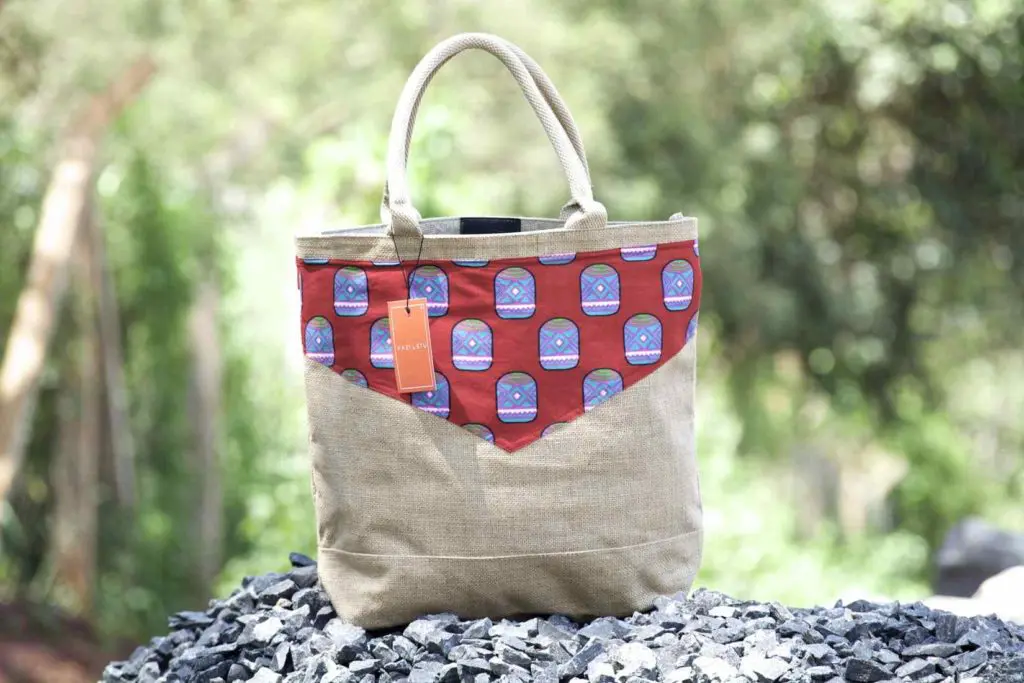
At some point during your travels, you will buy something, be that groceries or a souvenir. Try to avoid using single-use plastic bags for your purchases.
Why is this important?
A whopping one trillion single-use plastic bags are used annually across the globe – to put it into perspective, that’s nearly 2 million every minute. These petroleum-based plastics are causing an environmental disaster.
It’s arguable that such plastic will never decompose, as bacteria cannot break it down like they do organic matter such as food scraps (through a process called bio-degradation).
That is until it finds its way to the ocean. Researchers in Japan found that plastic in warm ocean water will degrade in as little as a year.
The problem with this?
Animals end up digesting small toxic bits of plastic or these end up washed up on the shore where humans are likely to come into direct contact.
What to use instead
A lot of shops now sell reusable shopping bags at the till, so you can purchase one as you buy food.
If you don’t feel like heading out to the shops you can try this one from Amazon
- EASY TO CARRY AROUND & ECO-FRIENDLY: Our reusable…
- X-LARGE CAPACITY & DURABLE: These grocery bags…
- RIP-STOP FABRIC & WATERPROOF:Our large shopping…
Alternatively, carry a backpack with you when you plan to shop. I have a fold-away one that fits in my pocket. This becomes very handy when I make impulse purchases.
Take a reusable water bottle
According to The Guardian, over 480 billion plastic drinking bottles were bought around the world in 2016, up from approximately 300 billion a decade before.
That’s a staggering one million plastic bottles every minute. Alarmingly, this number will reportedly increase another 20% by 2021.
What’s more, fewer than half of these bottles were collected for recycling, with a mere 7% collected and turned into new bottles. Most ended up in landfills or in the ocean.

Drinking enough water is important to stay healthy when traveling, and therefore the tendency is to buy bottles of water. Don’t contribute to the statistics and buy a reusable bottle for your trip. This is one of a few eco-friendly products you can take with you.
Where to buy a reusable water bottle
There are plenty of options to choose from these days – reusable water bottles are even sold in supermarkets! My suggestion would be to buy one you like before you travel. A good quality one will keep your water cold and hot drinks hot if you also choose to use it for that. You can easily get a cheaper replacement on the road if you misplace it.
Contigo Chill Vacuum-Insulated Stainless Steel Bottle
- Straw Lid Is Leakproof And Makes Cold Refreshment…
- Carry Loop Makes Straw Lid Easy To Transport And…
- Made With 18/8 Pro-Grade Stainless Steel To Ensure…
Mashable recommends their 10 favorite bottles, and the list is pretty good.
Safe drinking water
Be sure to check that there is safe drinking water where you are going before filling your bottle.
In places where the water is non-potable, hostels and hotels sometimes have water dispensers where you can fill your bottle for free. Alternatively, you can often purchase larger bottles (such as 5 liters). Use these to refill your personal bottle and store the larger bottle in your accommodation.
If purchasing water in bottles is simply unavoidable, attempt to recycle the bottles you do buy!
If you’re going camping or taking a road trip, take a large water carrier with you. Even better, purchase a Steripen or sterilizing drops which will allow you to drink water from natural resources without worrying about sanitation.
LifeStraw Personal Water Filter
The LifeStraw is a great tool to carry for hiking, camping, and travel. It can filter up to 1000 liters of water for drinking and removes a minimum of 99.9999% of waterborne bacteria.
- Protects against 99.999999% of bacteria (including…
- Ultralight and durable, the LifeStraw weighs less…
- Long-lasting membrane microfilter will last up to…
Take a reusable coffee cup
I drink a lot of coffee when I travel. Who doesn’t? One of my favorite things to do when I arrive at a destination is to seek out the local coffee shop. However, I make a conscious effort to avoid disposable coffee cups as part of my eco-friendly travel.
Here’s why:
16 billion disposable coffee cups are used globally each year!
The problem with this?
There are common misconceptions about how recyclable these cups actually are.
Big coffee companies actively promote that they are recyclable on their packaging. This is partially true, as they are made predominantly out of paper. However, the insides are laminated with plastic, which is tightly bonded to the paper (to make them able to contain liquid). Obviously, disposable lids are often also plastic.
This, along with the fact they are often contaminated with drink, makes them particularly difficult to recycle. In fact, they cannot be recycled at standard recycling plants and must be taken to special facilities. SOURCE
When you travel, sit in at the coffee shop and take your time over your roast. That way it will be in a mug. If you have to take it away, take a reusable cup with you and get it filled with coffee each morning.
Say no to straws
More than half a billion plastic straws are used every day around the world.
Why is this an issue?
For one, plastic straws are NOT recyclable. Moreover, they often end up dumped in the ocean; as reported by the LA Times, they are frequently found during beach clean-ups.
Not only is there the threat of constricting a sea animal, as previously mentioned plastic doesn’t biodegrade like organic material. Instead, it breaks down into small toxic pieces that clog the ocean and get consumed by marine life.
Straws are a real problem that are affecting our beautiful oceans.
What can you do about it?
Turn down straws when ordering drinks in bars or restaurants. Even better, invest in a reusable, eco-friendly travel straw such as The Final Straw.
Budget Alternative Travel Straw
The Final Straw is the original, but there are also budget alternatives:
- 【20PCS Included】 This 4 Packs reusable straws…
- 【Telescopic Design】This travel dringking straw…
- 【Wide Application】 Every portable metal straws…
Reducing Carbon Emissions for Eco-Friendly Travel
Travel (such as driving or flying) consumes energy and produces carbon emissions. These are harmful to the environment and are one of the principal causes of climate change. Follow the below tips to reduce your carbon footprint as part of a means of more eco-friendly travel.
You Might Like: 14 Best Books About Climate Change
Book direct flights

This might not be the most affordable option, however, planes release the most carbon during takeoff and landing as these are the most fuel-intensive phases.
Instead of taking the cheapest available flight with multiple stopovers, take the most direct flight to lessen your impact on the environment.
Not only will this mean you only take off and land once, but you will spend less time in transit.
I’ve written an article on how to find cheap flights which can help you keep the costs down!
Even better…
Travel overland
Flying is obviously the quickest and most convenient way to travel, especially between countries.
Unfortunately for us frequent travelers, the most obvious way to reduce your carbon footprint and practice eco-friendly travel is to fly less.
The flight industry has a disproportionately large effect on the environment; planes account for between four to nine percent of climate change impact.
What’s more, flying causes considerably more greenhouse gas emissions when compared with overland forms of transport.
The graph below shows that when compared to other modes of transport, such as driving or taking the train, flying has a greater climate impact per passenger kilometer.
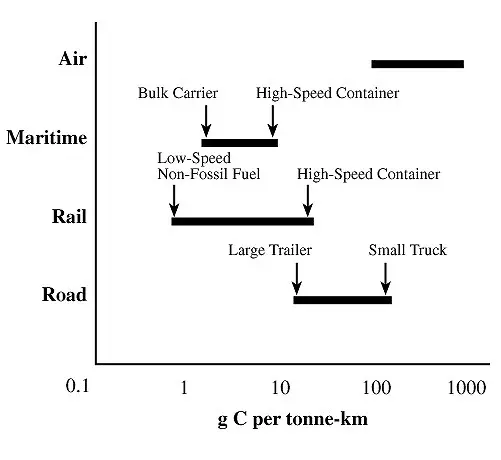
Graph courtesy of the David Suzuki Foundation
Consider taking an alternative mode of transport where possible, instead of flying. By taking the same journey by car, bus, or train you substantially lower your carbon emissions.
As you can see from the graph, trains are the most energy-efficient means of travel, however, sometimes this just isn’t a feasible option. We’re big fans of road trips at this site, and driving can also be a low-emission form of travel.
If you’re driving, try to fill your car with passengers. This makes the per capita emissions significantly lower.
Pack light
Sometimes you need a huge travel packing list. There are certain things you simply cannot travel without.
However, the more you pack when you travel, the heavier your mode of transport. The heavier your transport, the more damaging carbon dioxide it will emit into the atmosphere.
To make this more relatable, imagine yourself hiking. If you pack your backpack full of gear and it’s super heavy, you have to use more energy to lug it along the trail. The same applies to a bus/car/plane etc. When it has to carry more luggage, it uses more fuel.
If you don’t need to take something, leave it behind to help reduce carbon emissions.
Use public transport or walk when you’re at your destination
Taking public transport, or even better walking or cycling once at your destination is another means of minimizing your carbon footprint and practicing eco-friendly travel.
Rent a hybrid or electric vehicle
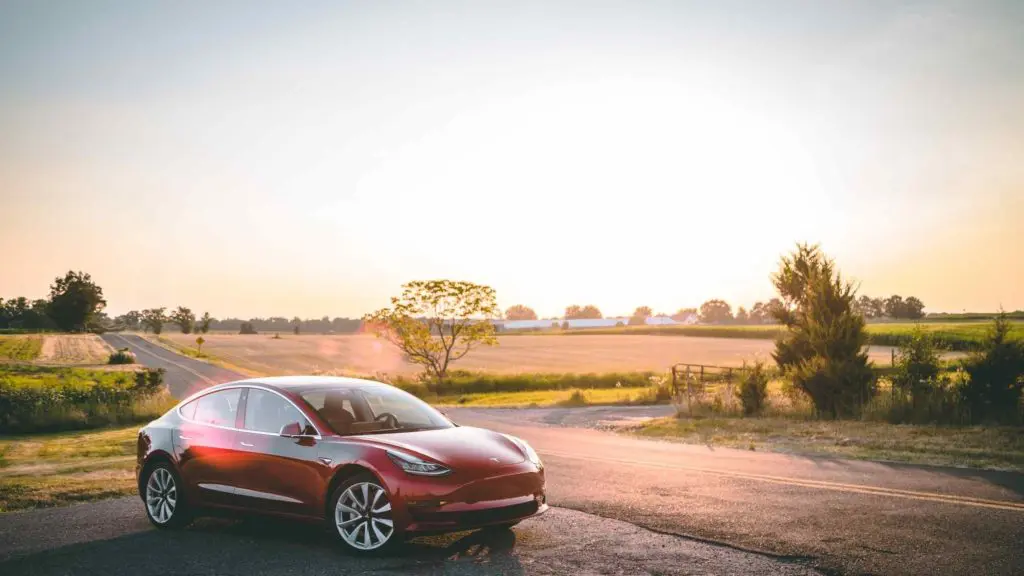
If you are renting a vehicle, consider renting an electric or hybrid model. They are much better for eco-friendly travel.
Why?
They use no (or considerably less) fuel and therefore reduce your carbon footprint.
Car rental companies are adding more and more to their fleets, making it much easier to find one. Enterprise has both hybrid and electric options, for example, while Hertz has a ‘Green Fleet’.
It might cost you a bit more to rent such a vehicle but remember: you will save on gas AND lower your emissions.
Offset your carbon footprint by donating to a charity
A carbon offset is a means to counterbalance your emissions by helping to pay for an equal carbon dioxide saving somewhere else.
Carbon offsetting does NOT reduce your carbon footprint, as you still make the journeys. However, it does give back to the environment in an attempt to balance the books.
How to carbon offset
Carbonfootprint.com has numerous projects you can donate to as part of eco-friendly travel.
Responsible Travel Practices for Eco-Friendly Travel
The below practices are simple, but they go a long way towards eco-traveling and lessening your impact.
Ensure electricals are switched off at home
Regardless of how long your trip is, ensure all electricals are switched off in your home before you leave. It may even be wise to completely unplug them, as just having something plugged in drains energy from the grid.
Ensuring you are fully disconnected will stop electricity waste, and save you money in the meantime.
Choose eco-friendly or “green” accommodation

Eco-hotels
As we start to understand the importance of eco-friendly tourism, eco-hotels or “green” hotels are becoming a bigger part of eco-friendly travel. These hotels make an effort to be environmentally sustainable through waste reduction and the conservation of water and energy.
How to find eco-friendly hotels
Unfortunately, at this point in time, there is no single resource to find eco-hotels around the world. Accommodation comparison sites such as booking.com and hotels.com are yet to include an “eco-hotel” filter. As such, finding an eco-hotel involves some manual research.
To start with, simply google “eco-hotel” or “green hotel” plus your destination to find a few options. There are multiple blogs that list the most environmentally friendly hotels in an area or country, especially for places where eco-tourism is starting to become a trend.
Once you have narrowed down a few options from the results, go to the hotels’ actual sites for more information on their practices and efforts to be sustainable.
Some things to consider when choosing a hotel:
- Is the hotel certified as eco-friendly by reputable organizations such as Green Globe (in the US), Rainforest Alliance, or Green Tourism?
- Does the hotel use any form of renewable energy to run?
- Does the hotel advocate the conservation of water, for example, through the reuse of bathroom towels?
- Do the rooms provide a thermostat to turn off the heating/air con?
- Will housekeeping tend to the room every day or is this on request?
- If toiletries are provided, are they disposable or in refillable containers?
- Are food and drink served in reusable containers?
- Does the hotel facilitate recycling?
Camping

Camping is an excellent eco-friendly travel alternative to staying in a hotel. If you’re taking a road trip, for example, why not spend a few nights out in nature? You will use considerably fewer resources. Of course, you may have to do without the luxuries a hotel provides, however, camping is a fun, accessible form of sustainable travel.
How to find campsites
Ioverlander is an awesome site/app that will show you campsites in a specific area.
It will tell you how much a site costs or if it is free, as well as what amenities are available.
Apartments/Air BnB
Staying in an apartment as opposed to a hotel allows you to easily practice the same eco-friendly habits you might have at home.
For example, you will have complete control over how often you wash your towels and sheets, you can use the lights only when absolutely necessary, and unplug electronics you’re not using.
How to find an apartment
Air BnB is one of my favorite travel companies that allows independent hosts all over the world to list their spaces for travelers to book.
Take part in eco-friendly travel activities and tours

There are a plethora of activities you can take part in during your trip that is eco-friendly and have minimal impact on the environment.
If you want to take part in something on your own (without a tour), generally anything that doesn’t involve a motor will stand you in good stead. Think cycling, walking, kayaking, sailing, swimming, snorkeling, etc.
Tours
When it comes to booking tours, often the cheapest option is the most appealing. However, this may not be the best choice in terms of environmental impact.
A specifically eco-friendly tour is more beneficial.
How to find an eco-tour
Ordinarily, eco-tours promote that their tours are sustainable, which makes them easy to find.
However, if you’re unsure as to whether a tour is actually eco-friendly, consider:
- Are the tour groups generally smaller (to lessen impact)?
- If the tour involves transport, is this energy-efficient?
- Does the tour provide education to the guests about the local environment?
- Does the tour operator mention conservation efforts in their description of the tour?
- Is the tour non-motorized? Eg. A walking or cycling tour as opposed to being taken around on a bus?
Eat and drink local

Food is one of the major contributing factors to climate change.
Why?
As consumers, we have become accustomed to products that are not local to us (I certainly enjoy eating avocados). However, these food products must often travel a long way before they’re sold. For example, the average piece of produce in the U.S. travels 1,500 miles.
Buying local food and drink, on the other hand, reduces carbon emissions by reducing the distance food has to travel before it gets to the consumer.
What’s more, by choosing local products, you support the local communities and businesses. I talk about this in my article on how to eat healthily while traveling.
The same applies to beer. Drinking local beer rather than internationally recognized brews means they have traveled less before they get to you.
How to eat and drink locally
This is simple enough.
Don’t search out food or drinks that you would usually have at home but aren’t typical to where you are.
Drink the local beers.
Try to shop at local markets and try the local delicacies!
As far as I’m concerned, one of the main perks of traveling and the best way to experience different cultures is trying the local cuisine.
Leave no trace
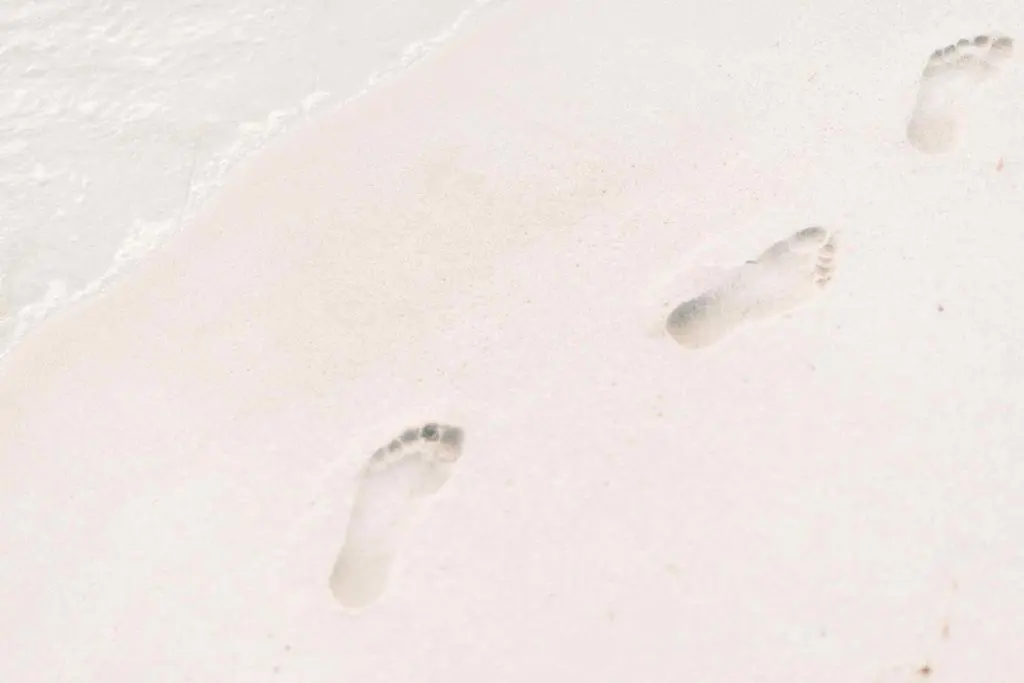
“Take only photos, leave only footprints”
Wherever you go, do your utmost to preserve the natural surroundings by leaving no trace. It goes without saying that you should not drop litter and should maintain the same eco-conscious practices as you would at home.
Correctly dispose of garbage
When traveling it can be difficult to know what to do with your trash. Ask your hotel or accommodation about where you can dispose of your waste and recycle it properly. When out and about, take your garbage with you until you find a sufficient disposal system.
Stick to trails when hiking
Trails are created and maintained to provide hikers with the best possible routes with minimal damage to the environment. Help preserve the beautiful places you travel to by sticking to them.
Why is this so important?
Well, leaving the trail may not sound like much, but it causes surface vegetation and animal habitats to be trampled beyond recovery. This can disturb wildlife and natural processes. It’s part of leaving no trace.
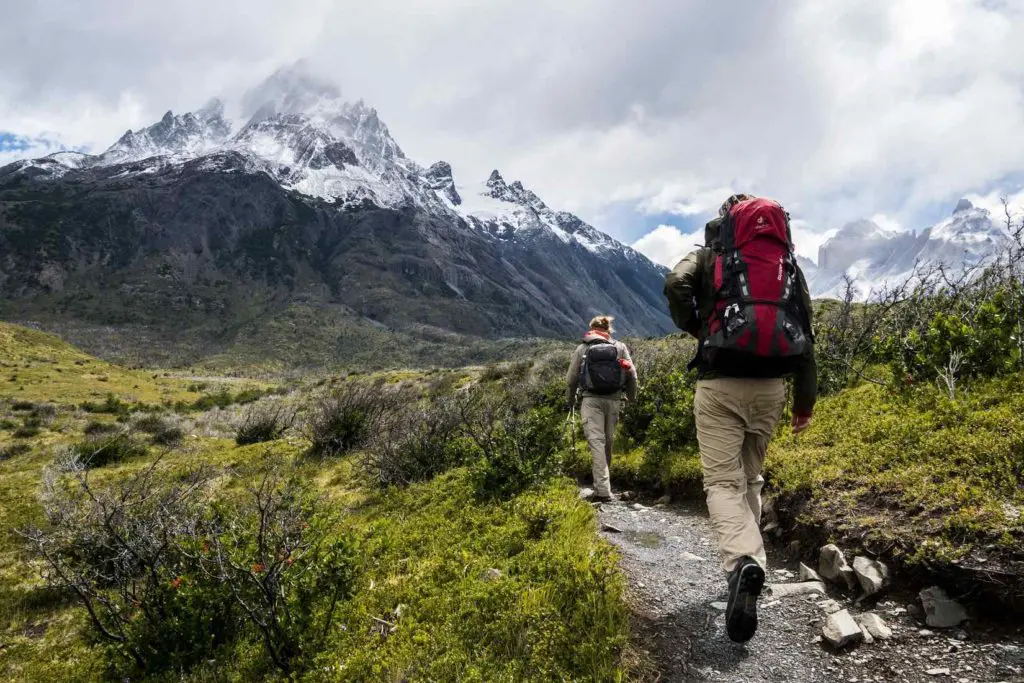
Leave somewhere better than you found it
These days, many eco-friendly travelers are taking the “leave no trace” philosophy even further.
How?
When you leave a place, you could leave it better than the way you found it.
This could simply mean picking up some trash that wasn’t yours and putting it in the garbage. It is a privilege to travel, so respect the places you go to.
Interact responsibly with wildlife
Observing wildlife while traveling can be an amazing experience, however, it is important that this is responsible.
In wildlife facilities
Ensure animals are treated humanely in any experiences you encounter.
How?
Make sure you research in advance.
To start with, only go to facilities where animals seem well-fed and have access to clean water. Animals should also have ample space with a sheltered area away from crowds. Such facilities should only offer an observation of animals engaging in natural behaviors in natural environments. National Geographic provides more advice on this HERE.
DO NOT go to facilities where animals are:
- visibly injured by trainers
- forced to perform or participate in activities that are unnatural
- forced to interact with tourists (rides, posing for pictures, etc.)
- in unclean or small enclosures
- chained up
In the wild
Respect wildlife that you see in the wild.
Do not approach wild animals or try to feed them as this can be harmful to them. They are safer and healthier when they haven’t become accustomed to people.

Eco-Friendly Travel – Pin for later
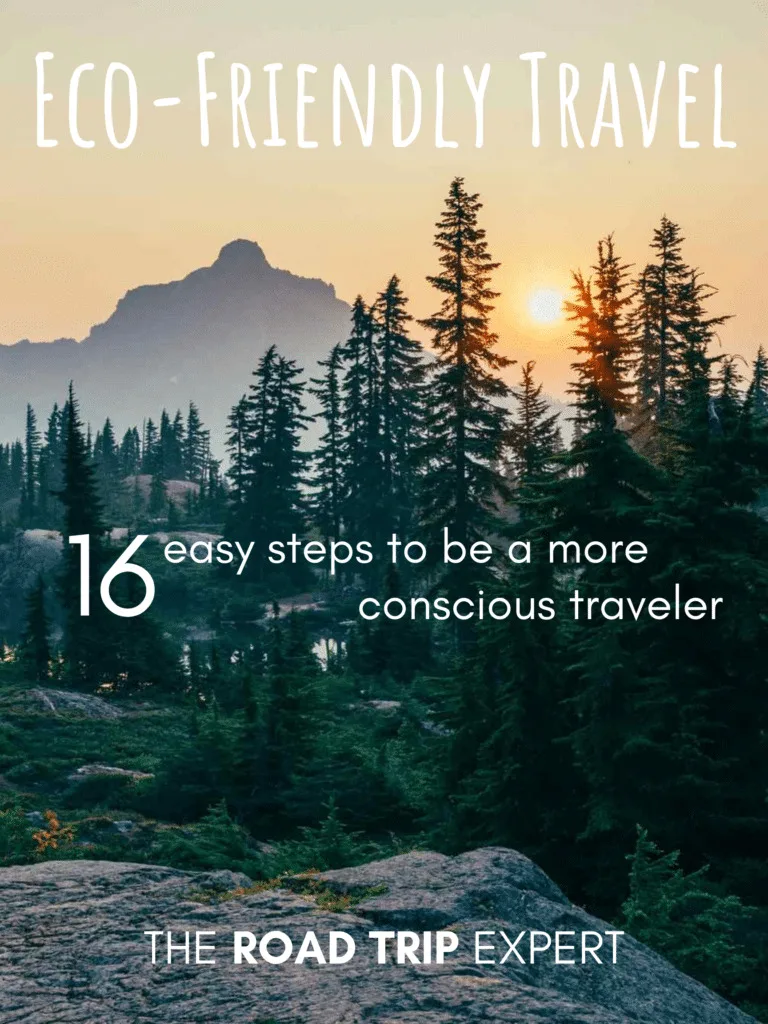
Now it’s your turn…
Which eco-friendly travel tip are you going to use first?
Or do you have any other suggestions for eco-traveling?
Either way, leave a comment below and let us know!
More From The Road Trip Expert
Whilst you’re here…
We have some new Travel Tips articles you might be interested in including an awesome article on keeping healthy whilst traveling. Feel free to check them out!
Disclosure: Some of the links in this article may be affiliate links. This means I earn a commission if you make a qualifying purchase, but this is at no additional cost to you. Thank you for supporting The Road Trip Expert.







Stella
Saturday 3rd of July 2021
Love your tips for traveling eco-friendlier. I'm big on being kinder to animals, especially when it comes to souvenirs and tourist attractions, but I hadn't thought about not feeding the wildlife. It makes perfect sense. And I live near a lot of wildlife, so I should have thought about it. Never too late to learn, though.
lifehackslite
Saturday 31st of October 2020
the reusable coffee cup is awesome, lovely article